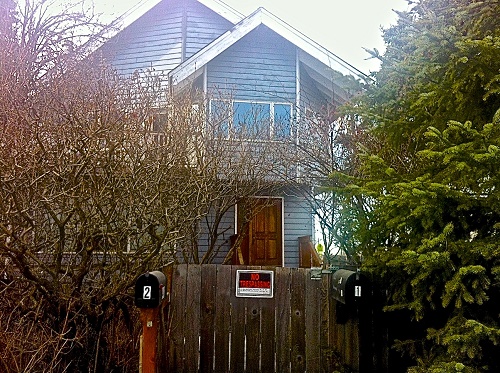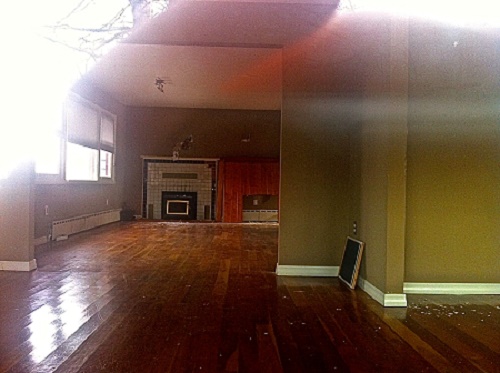
The larger of the two Government Hill houses KABATA plans to demolish.
Sometime before Sunday night when the Legislature adjourns, the House is expected to take up a concurrence vote on the Senate version of the Knik Arm bridge project that would build a bridge between Anchorage and Point McKenzie. It’s currently in what’s known as the “limbo file.” The House can take it up any time.
The idea for a bridge spanning the Knik Arm to open up access to that enticing plot of land across the water has been around for 100 years. The current plan has been in the works since 2003, and has seen multiple iterations. With a construction cost of about $900 million, it was initially going to be a government-funded project, with toll revenue paying back loans. Then it turned into a private-public partnership. Private sector involvement was supposed to be a guarantee, boosters said, that the project was viable. Now it’s back to being public, or completely government funded. When Gov. Sean Parnell announced the change, he spun it as a positive development.

Photo taken through a dirty window: The interior of a home KABATA plans to demolish. The floors are cherry and were refinished by former Rep. Pete Kott.
So far, the agency has spent roughly $100 million dollars on planning, design, environmental work, right-of-way acquisition and salaries. Parnell has requested that $55 million be put in the current budget for the project, $50 million of which are federal funds.
The caveat this time is that the project go through the process of getting a federal loan before it can sell bonds. It’s tried, and failed, to get that loan five times throughout the years. Many legislators have doubts that it will succeed now, but they’re voting on it anyway, in large part because the bridge is a priority for the powerful Valley delegation, including Co-Chair of House Finance Bill Stoltze and Senate President Charlie Huggins.
Another amendment in the Senate dictates that the agency in charge of the project, the Knik Arm Bridge and Toll Authority, or KABATA, cannot destroy property it acquires unless it gets the loan. However, it is allowed to destroy the four Government Hill properties it already acquired, at a cost of about $3 million. KABATA spokesperson Shannon McCarthy, said demolition probably wouldn’t happen until next year.
Maybe the bridge is a good thing for Anchorage and the Valley. Maybe it’s just a huge waste of money that will suck the life, and ideas of smart land-use, out of Anchorage. In any case, houses that are homes with history will be razed.
One of those Government Hill properties is a piano store, which is still being used as such. One was a hotel, the other two were houses. All of them were occupied. Now KABATA owns them and they are empty, which would appear to be a waste given the rental shortage in Anchorage.

Home that KABATA plans to demolish. It was formerly owned by Charles Wohlforth, who spent years remodeling it.
However, McCarthy said that federal regulation, which the agency abides by, dictates that if they rent those properties, they would be required to bring the properties up to federal safety standards and to move the residents when they had to leave.
So the plan now is that the houses will sit empty until they are razed.
By most standards, the two houses are nice. Many, including me, would think they are very nice. The city appraised the larger of the two houses at $402,100 in 2013. The smaller was appraised at $297,300.
That smaller one was the former home of Anchorage writer Charles Wohlforth. The house, built in the 1950s, was designed to look like a picture from a house that was featured in Better Homes and Gardens, Wohlforth said. Wohlforth lived in the 2,400 square foot house for 14 years. He moved out in 2002. He and his family completely gutted and remodeled it. They tore down and sheet-rocked walls and ceilings. They put in the fireplace, and a banister. They redid the bathrooms. He built a new Arctic entry. Cherry wood flooring covers much of the house. Former Rep. Pete Kott redid the floors after about 10 years of use.
On Wednesday, I drove over to the house and took pictures of the living room through a dirty window. It’s still gorgeous. The paint looks news. The floors still gleam. Even the fireplace has style.
“It’s sad,” Wohlforth said. “What a great place it was.”
I also took some pictures of the outside of the other house that is going to be razed. From the outside at least, this one doesn’t look as lovingly cared for as the Wohlforth house. But it’s
still a lovely home.
Contact Amanda Coyne at amandamcoyne@yahoo.com

I hate to see grand old houses torn down for no other reason than that they’re old and in the way of a project. Did no one consider relocating them?
KABATA is a needed project. It is unfortunate to lose the houses to it, but there are trade-offs sometimes, especially in a society that will not go to the effort to move a house out of the way rather than tear it down. That speaks more for our culture’s short-sighted consumerism than for the KABATA project.
This article represents what much of the media misses – – perspective. Great job.
Thank you for this interesting story Amanda. KABATA is now, more than ever, nothing but a self-employment agency desperate to create a image of progress to keep the paychecks flowing. Tearing down these structures certainly looks like progress. Now KABATA should be forced to either sell them or demolish them (with perhaps a small ceremony and ribbon cutting).
Since we are now in deficit spending, and facing huge costs for the AKLNG project, KABTA is now as probable as the Susitna Dam or the Ambler Road project. In a master stroke of displaced responsibility our legislators have created a stipulation that now the Knik Arm Bridge depends on federal funding that has already been denied five times for those “Alaska bridges to nowhere”. That was the final nail being silently driven into KABATAs’ coffin.
The truth be told, I would love to see the bridge built; however, I feel the agency, KABATA, has operated in a disgracful and cold-hearted manner. They have shown little respect or regard for the Government Hill commmunity. They have operated with reckless abandonment. Its leadership demonstrates callous indifferrence.
I’m glad that the legislature has stopped the unnecessary destruction of the neighborhood prior to secured and complete funding.
Yes, I want the bridge. However, I don’t want to destroy a neighborhood on the off chance that maybe, just maybe someday, the bridge will be built. Nice article.